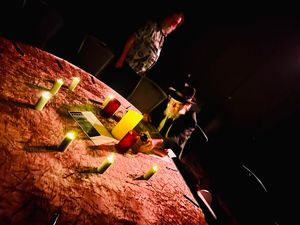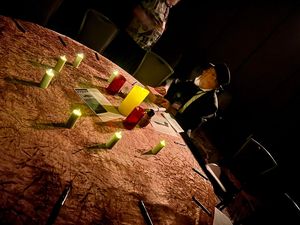

Séances, Spirit Medium, and Mystery Performer in Portland Oregon
| Seance at the Edgefield | Ghost Hunt at the Edgefield | Details | Home | Contact |
 The Seance Room |
 The Seance Room |
Imagine your guests are finishing dinner. A mysterious Jewish man enters and you introduce him as Rav Yitzhak, Spirit Medium.
Chiromancy first appears Hebrew literature in the fragmented Hakkarat Panim le-Rabbi Yishma'el, a series of works in the tradition of the circle of Merkabah mysticism. As such, it has no connection to anything astrological. From Hai Gaon (Mishnah, Tractate Ḥagigah, Oẓar ha-Ge'onim, section 12), the Merkabah mystics used chiromancy in order to ascertain whether a man was fit to receive esoteric teaching. They justified their use of chiromancy using quotes from scripture. In particular, "This is the book of the generations of humankind" (Gen. 5:1–2). It is noteworthy that the Hebrew word Toledot means (or could be translated as) "the book of a person's character".
Evidence of the chiromantic tradition pre-dating the Chasidic movement in Sefer ha-Minhagot (ca. 1215): at the conclusion of the Sabbath “they examined the lines of the palms and backs of the hands, because through the lines on the hands the sages would know a person's path and the good things in store for him." Zalman Schachter-Shalomi, in his book Spiritual Intimacy: A study of Counseling in Hasidism has a wonderful story about a Chasidic master who performs metoposcopy on an over-eager student to teach him a valuable lesson (needs a reference?).
Notwithstanding, the reading the face and palms in order to tell the future is in violation of the prohibition against divining auspicious times (Lev. 19:26), and the commandment to have perfect faith (Deut. 18:13). This falls under the category of “ask two Jews, get three answers.” However, there is no prohibition against reading a person's past, present, and character. These provide plenty of information to effect improvement on one's life.
Here is where it all begins:
"Now see to it to select from among all the people men of stature who fear G‑d, men of truth, who hate corruption…."(Ex. 18:21)
From Talmud (see Menachot 29a), we learn that Moses was puzzled by this until the Divine Presence taught him that, by examining the visages of those multitudes of men, he could select them [o be judges and leaders [from the thousands, hundreds, fifties etc.]. It was then that Moses learned this wisdom. That is the meaning of the verse, "…Now see to it to select from among all the people…. You, and no other, should see to it - know how to look at 600,000 men and select those worthy of leadership."
There are six aspects of a person's countenance that may be examined: the hair, the eyes, the nose, the lips, the face itself, and the hands - that is, the lines of the hands. Again, from the Talumd.
The Zohar (Zohar II:70a, Razin d'Razin) analyses the above verse in greater detail and expounds on it:
"Now see to it" - look at the hair, look the lines on the forehead and the eyebrows, "From among all the people". The eyes, look at the layers of the eyes, the pupil, iris, and the white of the eye, look (particularly) at the lines under the eye. "Men of stature" - those who have the ability to stand in the halls of the King glow in the face. The face itself, look at the lines and folds of the face, and the beard, "Who hate corruption…". The hands, look at the lines and marks of the hands.
This is the ancient basis for Hebrew metoposcomancy and chiromancy.
To schedule a séance party, a paranormal investigation with your friends, get your own mystic reading, or experience the control of demons, please contact Rav Yitzhak at Yitzhak [at] ravyitzhak.com.